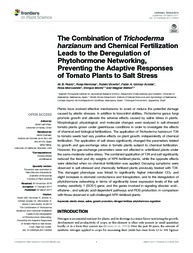The combination of trichoderma harzianum and chemical fertilization leads to the deregulation of phytohormone networking, preventing the adaptive responses of tomato plants to salt stress.
The combination of trichoderma harzianum and chemical fertilization leads to the deregulation of phytohormone networking, preventing the adaptive responses of tomato plants to salt stress.
Author(s): RUBIO, M. B.; HERMOSA, R.; VICENTE, R.; GOMÉZ-ACOSTA, F. E.; MORCUENDE, R.; MONTE, E.; BETTIOL, W.
Summary: Abstract: Plants have evolved effective mechanisms to avoid or reduce the potential damage caused by abiotic stresses. In addition to biocontrol abilities, Trichoderma genus fungi promote growth and alleviate the adverse effects caused by saline stress in plants. Morphological, physiological, and molecular changes were analyzed in salt-stressed tomato plants grown under greenhouse conditions in order to investigate the effects of chemical and biological fertilizations. The application of Trichoderma harzianum T34 to tomato seeds had very positive effects on plant growth, independently of chemical fertilization. The application of salt stress significantly changed the parameters related to growth and gas-exchange rates in tomato plants subject to chemical fertilization. However, the gas-exchange parameters were not affected in unfertilized plants under the same moderate saline stress. The combined application of T34 and salt significantly reduced the fresh and dry weights of NPK-fertilized plants, while the opposite effects were detected when no chemical fertilization was applied. Decaying symptoms were observed in salt-stressed and chemically fertilized plants previously treated with T34. This damaged phenotype was linked to significantly higher intercellular CO2 and slight increases in stomatal conductance and transpiration, and to the deregulation of phytohormone networking in terms of significantly lower expression levels of the salt overlay sensitivity 1 (SOS1) gene, and the genes involved in signaling abscisic acid-, ethylene-, and salicylic acid-dependent pathways and ROS production, in comparison with those observed in salt-challenged NPK-fertilized plants.
Publication year: 2017
Types of publication: Journal article
Unit: Embrapa Environment
Observation
Some of Embrapa's publications are published as ePub files. To read them, use or download one of the following free software options to your computer or mobile device. Android: Google Play Books; IOS: iBooks; Windows and Linux: Calibre.
Access other publications
Access the Agricultural Research Database (BDPA) to consult Embrapa's full library collection and records.
Visit Embrapa Bookstore to purchase books and other publications sold by Embrapa.

